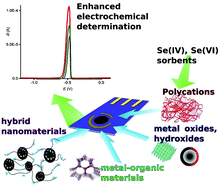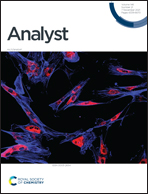Materials interacting with inorganic selenium from the perspective of electrochemical sensing†
Abstract
Inorganic selenium, the most common form of harmful selenium in the environment, can be determined using electrochemical sensors, which are compact, fast, reliable and easy-to-operate devices. Despite progress in this area, there is still significant room for developing high-performance selenium electrochemical sensors. To achieve this, one should take into account (i) the electrochemical process that selenium undergoes on the electrode; (ii) the valence state of selenium species in the sample and (iii) modification of the sensor surface by a material with high affinity to selenium. The goal of this review is to provide a knowledge base for these issues. After the Introduction section, mechanisms and principles of the electrochemical reduction of selenium are introduced, followed by a section introducing the modification of electrodes with materials interacting with selenium and a section dedicated to speciation methods, including the reduction of non-detectable Se(VI) to detectable Se(IV). In the following sections, the main types of materials (metallic, polymers, hybrid (nano)materials…) interacting with inorganic selenium (mostly absorbents) are reviewed to show the diversity of properties that may be endowed to sensors if the materials were to be used for the modification of electrodes. These features for the main material categories are outlined in the conclusion section, where it is stated that the engineered polymers may be the most promising modifiers.

- This article is part of the themed collection: Analyst Review Articles 2021


 Please wait while we load your content...
Please wait while we load your content...